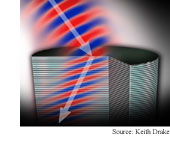|
NEWS
|
Semiconductor light-bender
 A semiconductor metamaterial that's relatively
easy to make carries out the unusual and useful feat of
bending infrared light backwards. This metamaterial, which
is easier to make than previous negative-index-of-refraction
materials and can be integrated with semiconductor devices,
could be used to channel lightwaves in optical communications
devices and as magnifying lenses for scientific and medical
imaging. (Negative
Refraction in Semiconductor Metamaterials, Nature
Materials, published online October 14, 2007)
A semiconductor metamaterial that's relatively
easy to make carries out the unusual and useful feat of
bending infrared light backwards. This metamaterial, which
is easier to make than previous negative-index-of-refraction
materials and can be integrated with semiconductor devices,
could be used to channel lightwaves in optical communications
devices and as magnifying lenses for scientific and medical
imaging. (Negative
Refraction in Semiconductor Metamaterials, Nature
Materials, published online October 14, 2007)
Printable power
A tangled mass of carbon nanotubes stores electricity
well because it's highly porous. The nanotube material
can be rolled or sprayed, making it possible to print
batteries onto surfaces. (Carbon
Nanotube Based Battery Architecture, Applied Physics
Letters, October 1, 2007)
Nanowire logic
Single cadmium sulfide nanowires form the backbones
of basic logic circuits of two or three transistors. The
nanowire circuits offer a route to fabricating extremely
dense, and therefore very powerful, computer chips. (High-Performance
Logic Circuits Constructed on Single CdS Nanowires,
Nano Letters, published online October 13, 2007)
Diamond drug delivery
In the lab, nanodiamonds carry the anticancer
drug doxorubicin hydrochloride into cancer cells and release
it inside the cells. Nanodiamonds are biocompatible and
could be used to deliver a range of drugs to particular
cells inside the body. (Active
Nanodiamond Hydrogels for Chemotherapeutic Delivery,
Nano Letters, published online October 5, 2007)
Sticky frog feet
A critter-foot-inspired material that contains
microscopic air- or oil-filled channels makes a powerful
and reusable adhesive. Inspired by the subsurface structures
of tree frog and cricket feet, the material is the latest
in a series of biomimetic adhesives. (Microfluidic
Adhesion Induced by Subsurface Microstructures, Science,
October 12, 2007)
Steely plastic
A transparent plastic is as strong as steel, thanks
to its nanoscale structure. The material is a composite
of nanoscale sheets of clay and polymer. (Ultrastrong
and Stiff Layered Polymer Nanocomposites, Science,
October 5, 2007) |
FEATURES
|
View
from the High Ground: ICL's John Pendry
Physics as machine tool, negative refractive
index, metamaterials, shattered wine glasses, higher capacity
DVDs, scientific backwaters, risk perception and practice,
practice, practice.
|
How
It Works: Quantum computing: qubits
Photons, electrons and atoms, oh my! These particles are
the raw materials for qubits, the basic building blocks
of quantum computers. |
|
 |
News RSS feed 
Blog RSS feed 
Bookshelf RSS feed

New: TRN's
Internet Services
TRN's Jobs Center
|
| |
|
| |
|
| |
"Physics
is to the rest of science what machine tools are
to engineering. A corollary is that science places
power in our hands which can be used for good or
ill. Technology has been abused in this way throughout
the ages from gunpowder to atomic bombs."
- John Pendry, Imperial College London |
|
| |
|
| |
Thanks
to Kevin from
GoldBamboo.com
for technical support |
|

